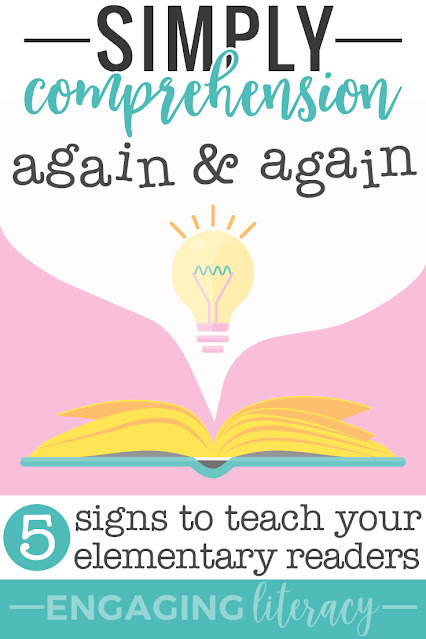Back for more game changing comprehension instruction that's simple but powerful? Teaching students to look for repetition in words, objects, characters, and events gives them an impactful anchor to recognize as a time to STOP and THINK.
(FYI-This is based on Notice and Note by Kylene Beers and Bob Probst. I've waited for years to share because there was supposed to be an elementary book but that never happened, so here we are. You can read more about the awesomeness of that book here.)
This post contains affiliate links which means Amazon tosses me some change whenever someone makes a purchase through one of these links and allows me feed my book habit!
Here's a scene from every elementary classroom: "Tell the important things that happened in the story." Buckle up. You're about to get the first and last things that happened in the story, or EVERY. SINGLE. THING.
But what is our instructional language are around identifying the most important events in the story? Usually pretty vague. Teaching students to stop and think when they identify repetition changes that.
The Sign: Again and Again
Again, the brain is a pattern making machine. The trick here is to move students beyond just recognizing repetition to stopping and thinking about why the author would do that.Anchor Chart & Text
After introducing the anchor chart (without the anchor images from the text), we first read All Are Welcome. The next day, we read Thank You, Omu! Here are three minilessons including the anchor images to guide you if you'd like.
The phrase "all are welcome" is repeated throughout the text. After reading the text (and they definitely notice the repetition!), we talk about why the author would repeat that phrase.
•Was the author just lazy and couldn't think of anything else to fill up the book? Of course not, author's are purposeful. So why would she do that?
•Why would this be important to the story?
•What big idea about life (theme) could we learn from this?
*For older readers, you might want to read Strictly No Elephants. "That's what friends do" is repeated in the text but is much more subtle than the repetition in All Are Welcome.
Repetition of Events
In Thank You, Omu, each time someone asks her for some of her delicious stew, she says yes, even though she is worried about having enough for dinner. (She runs out of stew in the end, but spoiler alert, everyone she gave food to brings something, and they all eat together.) Students will notice that again and again she is giving her stew away.
NOW WE'RE GOING TO GET SO FANCY
Let's put Opposites and Again and Again together.
•Did we have opposites in this story? Yes-she gave away her stew every time even though she was worried about running out.
•We have an opposite from beginning to end-she had a whole pot of stew in the beginning, but an empty pot at the end.
•Did we have again and again in this story? Yes, she gave away stew each time even though she was worried.
•Use the opposite of she had stew in the beginning and none in the end because she gave it away again and agin. What life lesson could we learn from that?
Congratulations, that was theme. Now you can teach theme by teaching skills that are transferrable to any text. Students have a framework for thinking through to determine the theme in a story.
Later, you can return to Again and Again to develop understanding of character traits. What does it teach us about Omu that she gives her stew away again and again? Now students have an anchor for thinking about character traits, so you'll get better answers than, "She was a girl."
Anchor Images
Add the anchor image for each text after reading and discussing them. These give visual anchors for students that may not be able to access all of the text on the chart.
The artwork from All Are Welcome is quickly recognizable (plus the back of the cover of the book becomes a poster!) The image of Omu and the stew pot is a quick connection to the action of giving her stew away again and again.
Extend the Lesson
Along with the books shared at the bottom of this post, here are more texts that are perfect for putting Opposites and Again and Again together for teaching retelling/plot and theme:
There will (eventually!) be five posts in this series. You can catch up on the first one here:
Simply Comprehension: Opposites
I'll add the others once they're completed!















